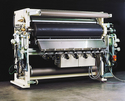Pagendarm – laying it on the line
9 October 2006
As an innovator in coating, drying and moisturizing technology for almost 50 years, Pagendarm is well placed to provide an insight into the current market situation. Converting Today talked with managing director Ralph Pagendarm and sales director Detlef Merklinger.
“We serve many different markets - labels, silicone, speciality tapes, medical,” said Ralph Pagendarm. “The general trend is that the smaller the company, the more likely they are to invest in new machines. The larger companies now prefer to set up new facilities in other countries. A trend today is that the smaller the company is in Europe, the more likely it is to invest in new machines here. The larger companies prefer to set up new facilities outside of Europe, in China.
“It's also a terribly competitive market - not for technology, but for price and delivery,” he stressed. “This is still accelerating; we don't see an end yet. There is an over 50 per cent probability that, once the technology of different suppliers is seen to be on the same level, the cheapest supplier will get the order. It's a case of price decides for something the buyer believes is the same as another. But machines are not the same - the difficulty for customers is how to distinguish the difference. Then the delivery time always has to be shorter.”
Detlef Merklinger added: “It used to be that coating companies would take machine partners with them to open new factories. Now, instead, they try to compete against us. We and our European competitors have already lost 20 per cent to Asian suppliers.”
Cost or quality
Ralph Pagendarm concurred: “The cost of one European coating line will pay for two from Asia - and their delivery time will also be shorter. But quality output requires highly skilled operators, so one machine can do better than two machines run less efficiently. A good example is a Chinese label supplier who had three similar quotes from Europe but chose two machines from Asia for 25 per cent of the European cost. They were slower, but then operators are cheaper there - and they can use solvent based silicones, so they don't need a five-roll coater.”
He emphasized: “In Asia they are thinking in the short term. They buy for one job, aiming to make a profit in two years. They don't worry about keeping it running for years. German companies buy a German machine for use in Germany, but machines from local suppliers are preferred for, say, a plant in Germany. This is a fact. Japan does well in selling to China, because they are nearer and cheaper. We can do business with the Chinese, but you have to be better in a way they understand, so they are prepared to pay more for it - and we have to keep costs down wherever possible.
On the US market, he said: “It hasn't seen big investments. European cost levels and the current exchange rates make it hard to sell to that market at the moment. Even US companies are making their investments in China. We still get orders, but it’s tough and will get tougher. Long term, I think small converting and print lines will be built where the products are made. We have to find innovations our competitors don't have, so that the customer will choose us - and we have to cut costs wherever we can.”
Detlef Merklinger added: “Most of our development work is for a highly sophisticated market, with high speed capability. The total market is very small for us and our competitors, so we have to make the most of it.“
Ralph Pagendarm stated: “The European trend to high speeds and widths means fewer projects and a smaller market. But we aim to be technically better than our competitors. Technical factors are a major part of project development and planning. We were the first European supplier to pull out of manufacture, which made us cheaper. When our competitors realized we were right, they started to follow us. Being part of a big group (Jagenberg), gives us an advantage in out-sourcing manufacture and components - and quality without losing the price advantage. We always invest R&D in cutting costs first, before developing new technology. It's very important to reduce costs without affecting quality.
In conclusion, he said: “On the development side, we have done a lot of work on curtain coating for hotmelt acrylics. We've had a lot of enquiries about this, but there is no sign of companies ready to invest in it yet. We have co-operated with BASF in R&D on this. There are many good niche products in the European market, and when one becomes a commodity product, it will take off.”
| Contact |
| Pagendarm |



